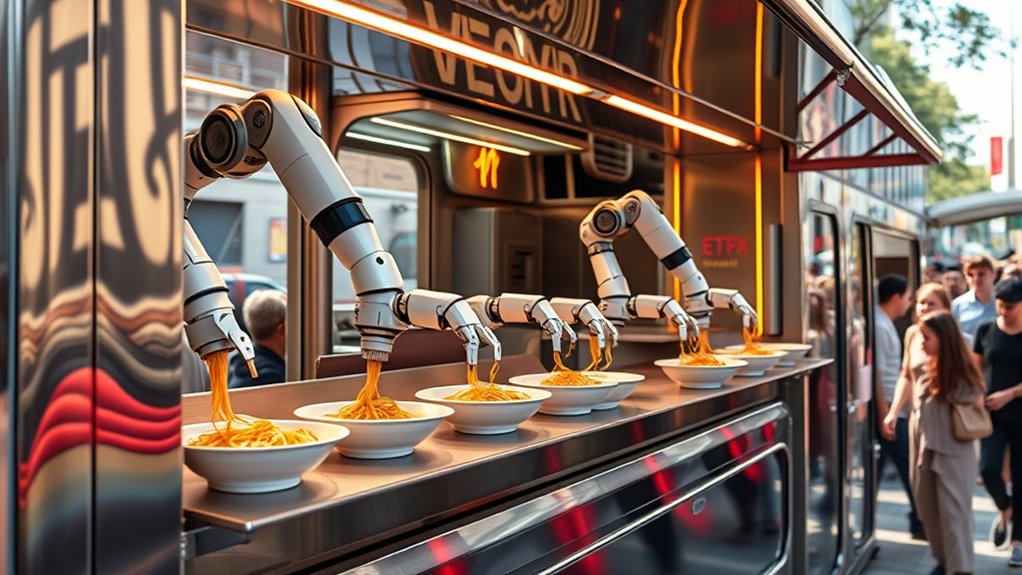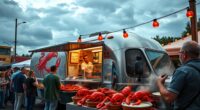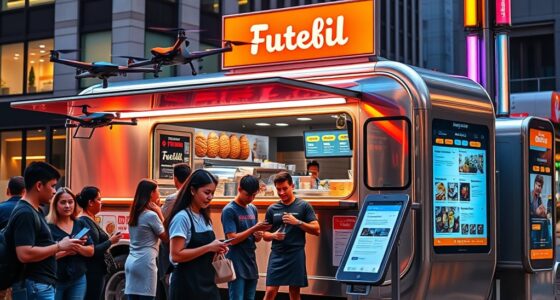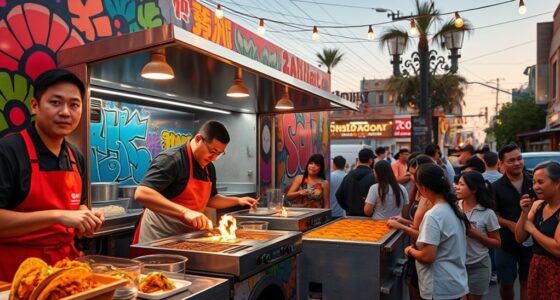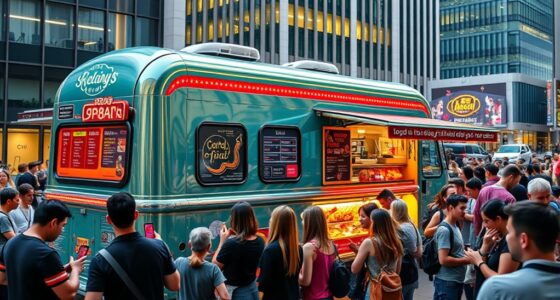Robotics is transforming food truck service by automating ordering with digital kiosks or apps and speeding up food prep with robotic assistants, boosting efficiency and reducing wait times. Self-driving trucks and delivery vehicles use AI and sensors to navigate city streets safely and deliver fresh produce faster. These innovations lead to smoother operations, lower costs, and a better customer experience. To discover how these technologies are shaping the future of mobile food service, keep exploring this exciting trend.
Key Takeaways
- Robotics automate food preparation and presentation, enhancing consistency, speed, and visual appeal in food trucks.
- Autonomous delivery vehicles and self-driving food trucks improve efficiency, reduce costs, and expand service reach.
- Digital kiosks and robotic order processing streamline customer interactions, decreasing wait times and increasing throughput.
- Automated inventory and cleaning systems maintain hygiene standards while optimizing stock management.
- AI-driven customer engagement and virtual menus enrich the dining experience and enable personalized marketing.
Automated Ordering and Payment Systems
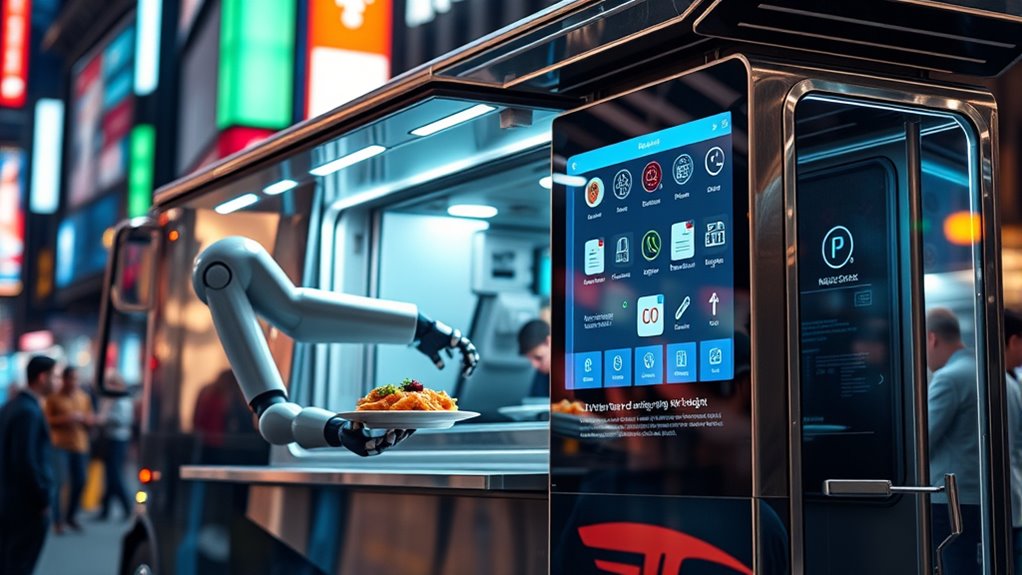
Automated ordering and payment systems are transforming how food trucks operate by streamlining the customer experience. These systems allow you to place orders quickly through digital kiosks or mobile apps, reducing wait times and minimizing errors. With robotic cooking integrated into the process, meals are prepared efficiently and consistently, ensuring quality every time. Additionally, automated inventory management keeps track of ingredients in real-time, helping you avoid shortages and overstocking. This seamless integration means you can focus more on service and less on manual tasks. Customers appreciate the convenience of contactless payments, making transactions faster and safer. Moreover, understanding food safety practices ensures that automated systems maintain high hygiene standards, preventing contamination. Implementing maintenance schedules for automated equipment is crucial to prevent unexpected breakdowns and ensure continuous operation. Staying vigilant about cybersecurity is also important, as digital systems can be vulnerable to cyber threats, which could compromise customer data and disrupt service. Incorporating regular staff training on system operation and troubleshooting can further enhance reliability and customer trust. Overall, these automation tools enhance efficiency, boost customer satisfaction, and help your food truck stay competitive in a busy market.
Robotic Kitchen Assistants and Food Preparation

Robotic kitchen assistants can improve your food prep by ensuring precise measurements and consistent results every time. They help boost speed and efficiency, allowing you to serve more customers quickly. With these robots, your meals stay high quality, regardless of how busy it gets. Incorporating goal setting techniques can further optimize your workflow and ensure continuous improvement in your service. Additionally, assessing vendor reliability in your robotic equipment can help prevent operational disruptions and maintain smooth service. Furthermore, integrating color accuracy considerations into food presentation can enhance visual appeal and customer satisfaction. Staying informed about resources and tools available for food trucks can also support implementing these advanced technologies effectively. Regular maintenance and technological upgrades are crucial to keep your robotic systems running smoothly and to adapt to new innovations in food service.
Precision in Cooking
How do robotic kitchen assistants achieve such remarkable precision in food preparation? It all comes down to advanced robotic cooking systems that control every movement and measurement. These robots use sensors and software to ensure ingredient precision, reducing waste and enhancing consistency. Their precise movements allow for exact portioning and cooking times, resulting in perfectly prepared dishes every time. Here’s a closer look at how this works:
| Task | Technique Used | Benefit |
|---|---|---|
| Ingredient Measuring | Laser-guided sensors | Accurate portion sizes |
| Cutting & Chopping | Robotic arms & blades | Uniform food pieces |
| Cooking Timing | Automated timers & sensors | Consistent doneness |
| Plating | Precision placement | Attractive presentation |
This level of control makes robotic cooking a game-changer for food trucks seeking consistency and quality. Additionally, the integration of store hours data allows for better planning of operational hours to meet customer demand.
Speed and Efficiency
Have you ever wondered how robotic kitchen assistants dramatically boost the speed and efficiency of food preparation? These robots streamline processes, reducing wait times and increasing output. They handle multiple tasks simultaneously, from chopping ingredients to cooking meals, all while maintaining consistency. Robotic customer interactions enable smoother service, allowing customers to place orders quickly and accurately. Automated inventory management keeps stock levels ideal, preventing delays caused by shortages. Additionally, integrated paint sprayer technology allows for quick and precise finishing of food presentation, enhancing overall quality. Here are some key benefits:
- Faster meal prep and delivery
- Reduced human error
- Seamless order processing
- Better resource management
Consistent Meal Quality
By automating key steps in food preparation, robotic kitchen assistants guarantee each meal meets consistent standards. Robotic cooking ensures precise measurements and timing, reducing variability in food quality. This mindset to attract abundance in career helps maintain optimal cooking conditions, further ensuring uniformity. Additionally, robotic kitchen assistants can quickly adjust portions and ingredients, maintaining ideal food quality. The result is a reliable, uniform product that elevates customer satisfaction. As a result, food trucks benefit from enhanced reputation and repeat business. Furthermore, integrating quality control measures into robotic systems can proactively detect and address potential issues, ensuring ongoing consistency. Incorporating advanced sensors and monitoring enhances the system’s ability to maintain high standards. Implementing mindfulness techniques in system design can also improve operational efficiency and reduce errors. Overall, robotic cooking plays a crucial role in delivering consistent, high-quality meals that keep customers coming back.
Self-Driving Food Trucks and Delivery Vehicles

Self-driving food trucks and delivery vehicles rely on advanced autonomous navigation systems to move efficiently through busy streets. These vehicles can improve delivery times and reduce costs, making your food service more competitive. However, safety concerns and regulatory hurdles remain as you consider integrating this technology into your operation. Additionally, maintaining compliance with Legal Information is essential to ensure proper operation within existing laws. Incorporating attention during development and deployment can help optimize safety measures and operational efficiency. Staying informed about AI safety standards can further enhance trust and reliability in autonomous food service vehicles. Implementing safety protocols is critical to minimizing risks and ensuring passenger and pedestrian safety, especially since the Power Consumption of Heated Mattress Pads demonstrates the importance of energy efficiency in modern technology.
Autonomous Navigation Systems
Autonomous navigation systems are transforming how food trucks and delivery vehicles operate, enabling them to traverse city streets without human drivers. These systems use advanced sensors, GPS, and AI to navigate safely, even in complex urban environments. This technology supports urban farming initiatives by delivering fresh produce directly to consumers, reducing transportation emissions, and increasing food safety standards. You’ll see fewer accidents and smoother traffic flow as these vehicles adapt to changing conditions in real time. Additionally, support hours for maintenance and updates are often scheduled during off-peak times to ensure minimal disruption, leveraging high-efficiency models for maximum operational uptime.
Enhanced Delivery Efficiency
Enhanced delivery efficiency is revolutionizing how food trucks and delivery vehicles operate, ensuring faster and more reliable service. Self-driving trucks optimize routes, reducing delivery times and costs. They also facilitate robotic customer interactions, providing order updates and answering questions seamlessly. Inventory management is integrated into these systems, allowing real-time stock tracking and automatic restocking alerts. This streamlines operations and minimizes errors. The table below highlights key benefits:
| Feature | Benefit | Impact |
|---|---|---|
| Self-driving vehicles | Faster, reliable deliveries | Increased customer satisfaction |
| Robotic customer interactions | 24/7 communication | Improved engagement |
| Real-time inventory management | Less waste, stock accuracy | Cost savings |
| Route optimization | Reduced delivery times | Higher efficiency |
| Automated restocking | Less manual oversight | Reduced labor costs |
Safety and Regulatory Challenges
As self-driving food trucks and delivery vehicles become more common, ensuring their safety and compliance with regulations presents significant challenges. Liability concerns arise if accidents happen, making it vital to establish clear responsibility. You also face compliance hurdles, such as meeting local traffic laws and safety standards for autonomous systems.
Key issues include:
- Determining liability in accidents involving autonomous vehicles
- Steering through evolving regulations across different jurisdictions
- Ensuring cybersecurity to prevent hacking or control interference
- Addressing public safety concerns and building consumer trust
These challenges require continuous updates to safety protocols and legal frameworks. Overcoming them is essential for autonomous food trucks to operate smoothly and safely within existing regulatory environments.
Enhancing Customer Experience With Robotics
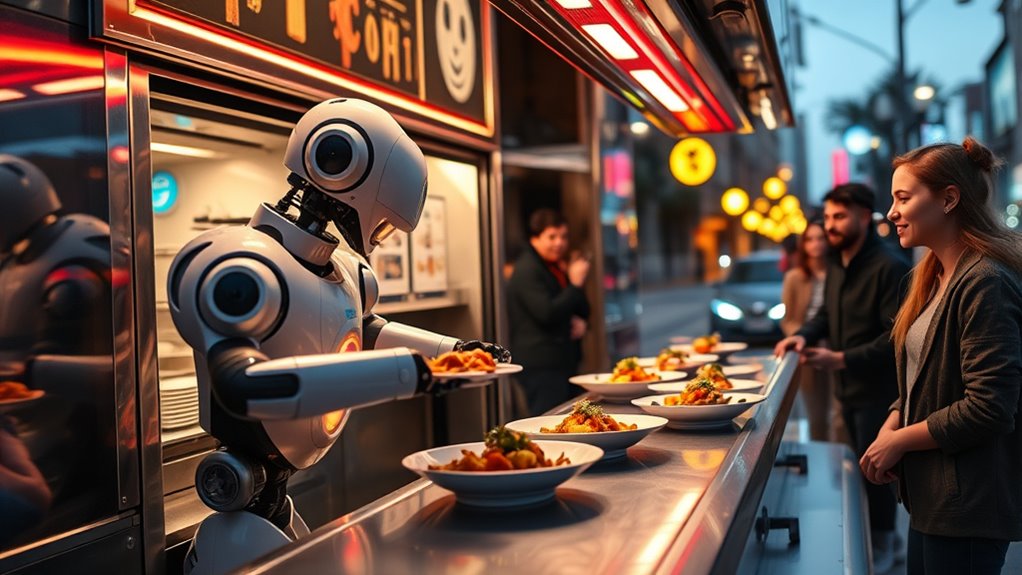
Robotics can considerably improve your experience when ordering from a food truck by making interactions quicker and more efficient. Robotic customer interaction allows you to place orders smoothly, reducing wait times and minimizing errors. Some food trucks now use virtual reality menus, giving you an immersive way to explore options before ordering. This technology helps you make informed choices and enhances engagement. Robots can also assist with payment processing, streamlining the checkout process. With these innovations, your experience feels more modern and personalized. Instead of waiting in long lines or dealing with miscommunications, you enjoy a seamless service that adapts to your preferences. Robotics transforms how you interact with food trucks, making each visit more enjoyable and hassle-free.
Streamlining Operations and Reducing Costs
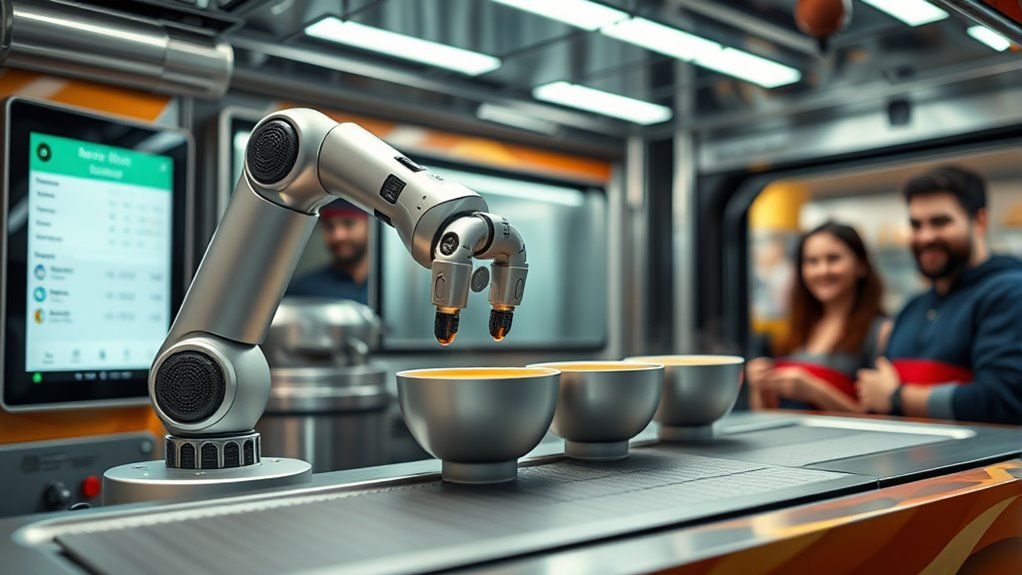
Implementing robotics in food truck operations can substantially streamline daily tasks and cut costs. Robotics automates routine functions, reducing labor expenses and minimizing errors. For example, robotic inventory systems keep track of stock levels in real-time, preventing shortages or overstocking. Automated cleaning systems ensure hygiene standards are maintained with less manpower, saving time and water. These innovations help you operate more efficiently and allocate resources to customer service. You’ll also benefit from fewer delays and smoother workflows. The key advantages include:
- Robotic inventory management for precise stock control
- Automated cleaning that saves labor and ensures sanitation
- Reduced waste through better inventory oversight
- Faster service with streamlined prep and cleanup processes
Innovating Menu Concepts and Customization
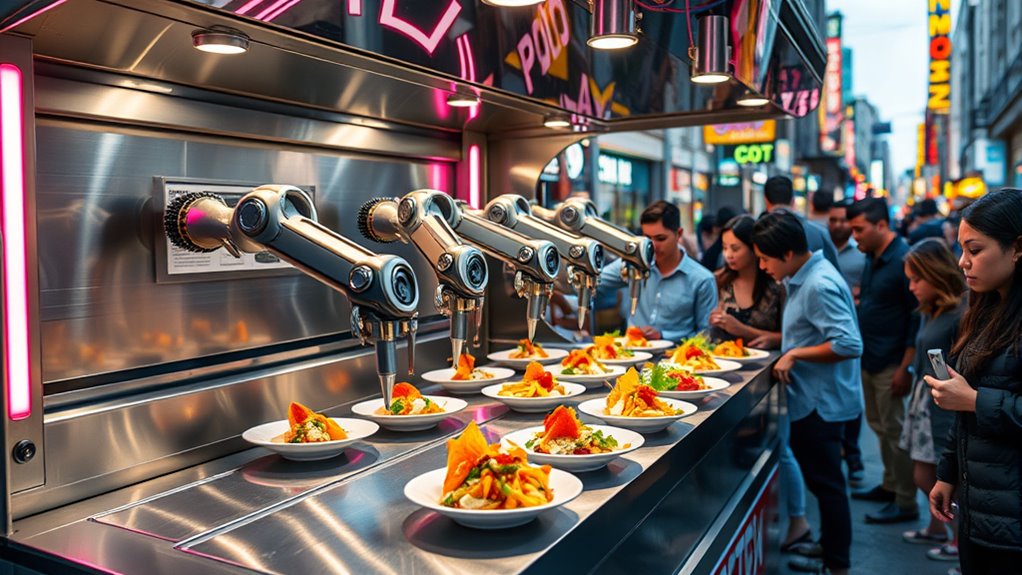
Innovating menu concepts and offering customization options can set your food truck apart in a competitive market. By embracing menu innovation, you attract diverse customers seeking unique flavors. Robotics enable quick adjustments to ingredients, allowing you to customize dishes precisely to customer preferences. Consider the following example of menu options:
| Classic Options | Customizable Add-ons |
|---|---|
| Cheeseburger | Extra cheese, bacon |
| Veggie Wrap | Spicy sauce, extra veggies |
| Tacos | Different salsas, proteins |
| Smoothies | Additional fruits, toppings |
| Salads | Choice of dressings |
This approach encourages customer customization, boosts satisfaction, and increases repeat business. Robotics help streamline these innovations, making customization seamless and efficient.
Data Collection and Personalized Service
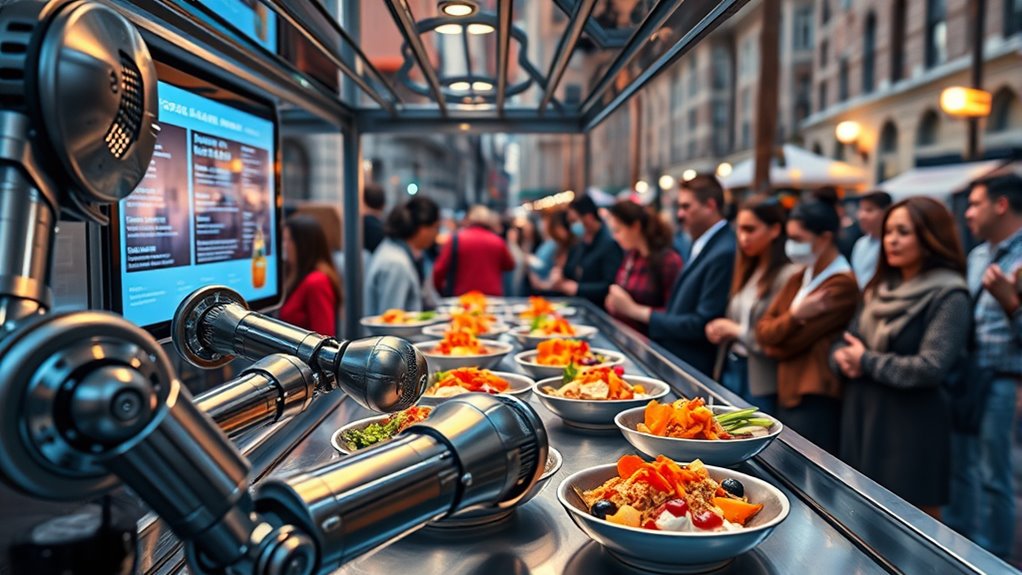
How can you leverage data collection to enhance your food truck’s service? By integrating sensors and utilizing data analytics, you can gather real-time insights into customer preferences and operational efficiency. Sensor integration allows you to track inventory levels, monitor order times, and analyze customer flow. With this data, you can personalize offerings, reduce wait times, and improve overall customer satisfaction.
Leverage sensors and analytics to personalize service, optimize operations, and boost customer satisfaction in your food truck.
- Use sensors to identify popular menu items and adjust stock accordingly
- Analyze customer behavior patterns for targeted marketing
- Optimize staffing based on peak times identified through data
- Offer personalized promotions based on purchase history
These strategies help you deliver a tailored experience, boost loyalty, and stay ahead in a competitive market—all driven by smart data collection.
Challenges and Limitations of Robotics in Food Trucks

While robotics can streamline food truck operations, they also introduce significant challenges and limitations. Staff training becomes essential, as your team needs to learn how to operate and troubleshoot advanced systems. Without proper training, robots can cause delays or errors, reducing efficiency. Maintenance challenges also pose a hurdle; robotic systems require regular upkeep, repairs, and updates, which can be costly and time-consuming. Additionally, technical failures can disrupt service, frustrating customers and affecting your reputation. Limited flexibility in handling unpredictable situations remains a concern, as robots are programmed for specific tasks. Overall, integrating robotics demands careful planning, investment in staff education, and ongoing maintenance, making it a complex shift rather than a simple upgrade.
Future Trends and Opportunities in Robotic Food Service

Advancements in robotics are opening up exciting possibilities for the future of food truck service. You can expect more sophisticated robotic customer interaction, making ordering faster and more personalized. AI-driven marketing will enable food trucks to analyze customer preferences and tailor promotions in real-time, boosting sales and loyalty. Future trends include autonomous delivery, allowing food trucks to reach more customers efficiently. Enhanced robotics will also improve order accuracy and speed, reducing wait times. Additionally, integrating smart sensors and data analytics will help operators optimize inventory and staffing. These innovations will transform the customer experience, making food trucks more dynamic and responsive. As these trends develop, you’ll see a more seamless, engaging, and efficient food service environment driven by robotics.
Frequently Asked Questions
How Do Robots Ensure Food Safety and Hygiene Standards?
Robots guarantee food safety and hygiene standards by strictly following food safety protocols and hygiene maintenance procedures. You can rely on them to sanitize surfaces regularly, maintain consistent temperatures, and handle food with precision to prevent contamination. Their programmed routines minimize human error, ensuring high hygiene standards. By automating these tasks, robots help keep your food truck cleaner and safer, providing peace of mind for both you and your customers.
Are Robotic Food Trucks Environmentally Sustainable?
Robotic food trucks can be environmentally sustainable when they use sustainable energy sources like solar or wind power, reducing reliance on fossil fuels. They also benefit from eco-friendly materials in construction, which lessen environmental impact. By incorporating energy-efficient systems and recyclable components, you help minimize waste and carbon footprint, making robotic food trucks a greener alternative that supports eco-conscious practices in the food industry.
What Training Is Required for Staff Working With Robotic Systems?
Did you know that 85% of successful robotic operations rely on thorough staff training? When working with robotic systems, you’ll need specialized staff training to understand equipment functions and safety protocols. This guarantees smooth robotic operation and reduces errors. You’ll learn how to troubleshoot and maintain the robots, making your food truck more efficient. Proper training empowers you to manage technology confidently, enhancing customer service and operational safety.
How Do Robots Handle Customer Complaints or Special Requests?
Robots in food trucks handle customer interaction and complaint resolution through programmed responses and AI-driven communication. When a customer has a special request or issue, the robot can recognize keywords and respond with appropriate solutions or escalate the matter to human staff if needed. This seamless interaction guarantees efficient service, maintains customer satisfaction, and allows robots to manage complaints professionally while providing personalized assistance tailored to each customer’s needs.
What Are the Legal and Insurance Considerations for Robotic Food Trucks?
Sure, because nothing says “fun weekend” like worrying about robotic food trucks breaching legal compliance or voiding insurance policies, right? You need to guarantee your robotic food truck meets all legal standards, from health codes to safety regulations. Don’t forget to review insurance policies to cover potential robot malfunctions or accidents. Staying proactive keeps your innovative food venture protected, so you can focus on serving customers, not legal nightmares.
Conclusion
Robotics are transforming food trucks into a well-oiled machine, turning the traditional roadside stand into a high-tech culinary adventure. As these machines become smarter and more efficient, they’re like a symphony of innovation, playing in perfect harmony to serve you faster and better. While challenges remain, embracing these changes promises a future where your food experience is seamless, personalized, and exciting—proof that technology is the secret ingredient in the recipe for success.
